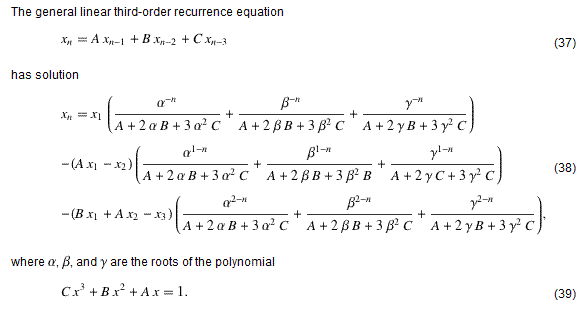Math Is Fun Forum
You are not logged in.
- Topics: Active | Unanswered
Pages: 1
#1 2010-04-01 10:04:45
- White_Owl
- Member
- Registered: 2010-03-03
- Posts: 106
three zeros in a row
The problem is: How many bit strings of length n contains three zeros in a row?
Just by brute force listing of strings I got the numbers 1, 3, 8, 20, 47, 107, 238, 520, 1121 for n=3...11.
Now I'd like to make recursive and closed-form functions to calculate those numbers, but no luck for two days...
Offline
#2 2010-04-01 10:53:13
- mathsyperson
- Moderator

- Registered: 2005-06-22
- Posts: 4,900
Re: three zeros in a row
I think it's easier to list all the length-n strings that don't contain three zeroes in a row.
There are three types of these:
- Type 1: those that end with 1
- Type 2: those that end with 10 (and the string 0)
- Type 3: those that end with 100 (and the string 00)
You can get relations out of these quite nicely.
Starting with length-1 strings, we have 0 and 1.
That is one Type 1 string, one Type 2 string and no Type 3 strings.
We can write this as (1,1,0).
The length-2 strings are 00, 01, 10, 11.
The number of types can be summarised as (2,1,1).
The length-3 strings are 001, 010, 011, 100, 101, 110, 111.
This summarises as (4,2,1).
You can get the triple for a length-n string by using the triple for the length-(n-1) string.
For every length(n-1) string, you can get a Type 1 length-n string by adding a 1 to the end.
For every Type 1 length(n-1) string, you can get a Type 2 length-n string by adding a 0.
And similarly, you get a Type 3 length-n by adding to a Type 2 length(n-1).
Therefore, if the triple for one length of string is (a,b,c), then the triple for the next length of string will be (a+b+c, a, b).
Going back to your question, you can find the number of strings that do contain 000 by finding the number that don't, and taking this away from 2^n.
Hopefully I've explained that well enough, but here's a table to show what I mean.
Length | Type 1s | Type 2s | Type 3s | Total | Strings containing 000
--------------------------------------------------------------------------
1 | 1 | 1 | 0 | 2 | 0
2 | 2 | 1 | 1 | 4 | 0
3 | 4 | 2 | 1 | 7 | 1
4 | 7 | 4 | 2 | 13 | 3
5 | 13 | 7 | 4 | 24 | 8
6 | 24 | 13 | 7 | 44 | 20
7 | 44 | 24 | 13 | 81 | 47
8 | 81 | 44 | 24 | 149 | 107
9 | 149 | 81 | 44 | 274 | 238
...Why did the vector cross the road?
It wanted to be normal.
Offline
#3 2010-04-02 03:11:43
- White_Owl
- Member
- Registered: 2010-03-03
- Posts: 106
Re: three zeros in a row
Thank you.
Somehow I always overlook the approach by cases ![]()
So the recursive form should be something like this:
which can be somewhat simplified into:
hmmm.... interesting...
And now I'll embark on the quest to convert this into closed form. Wish me luck... and brain.
Offline
#4 2010-04-02 09:01:35
- JaneFairfax
- Member

- Registered: 2007-02-23
- Posts: 6,868
Re: three zeros in a row
http://mathworld.wolfram.com/LinearRecu … ation.html

Last edited by JaneFairfax (2010-04-04 08:55:26)
Offline
#5 2010-04-03 14:45:30
- Ricky
- Moderator

- Registered: 2005-12-04
- Posts: 3,791
Re: three zeros in a row
That's an amazing result Jane, one which I had never heard. Thanks!
"In the real world, this would be a problem. But in mathematics, we can just define a place where this problem doesn't exist. So we'll go ahead and do that now..."
Offline
#6 2010-04-04 04:10:47
- soroban
- Member
- Registered: 2007-03-09
- Posts: 452
Re: three zeros in a row
.
. .
. .
. .
.
Offline
Pages: 1